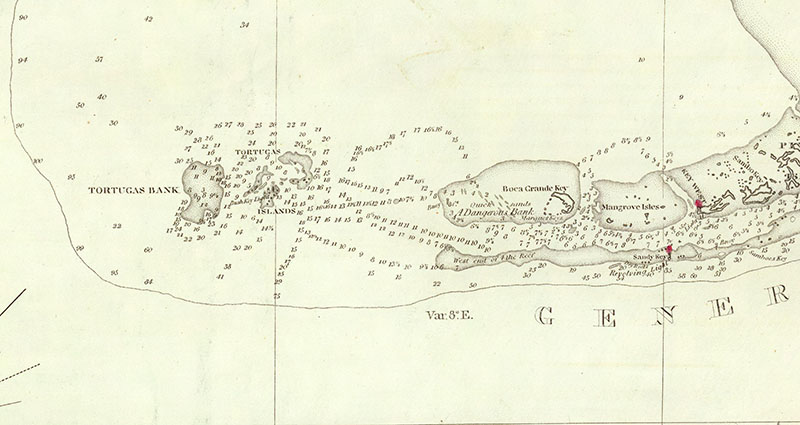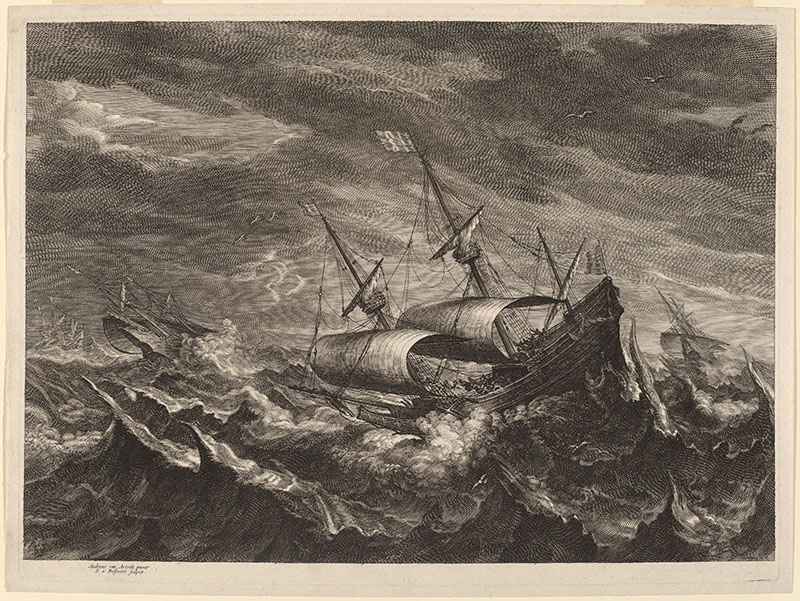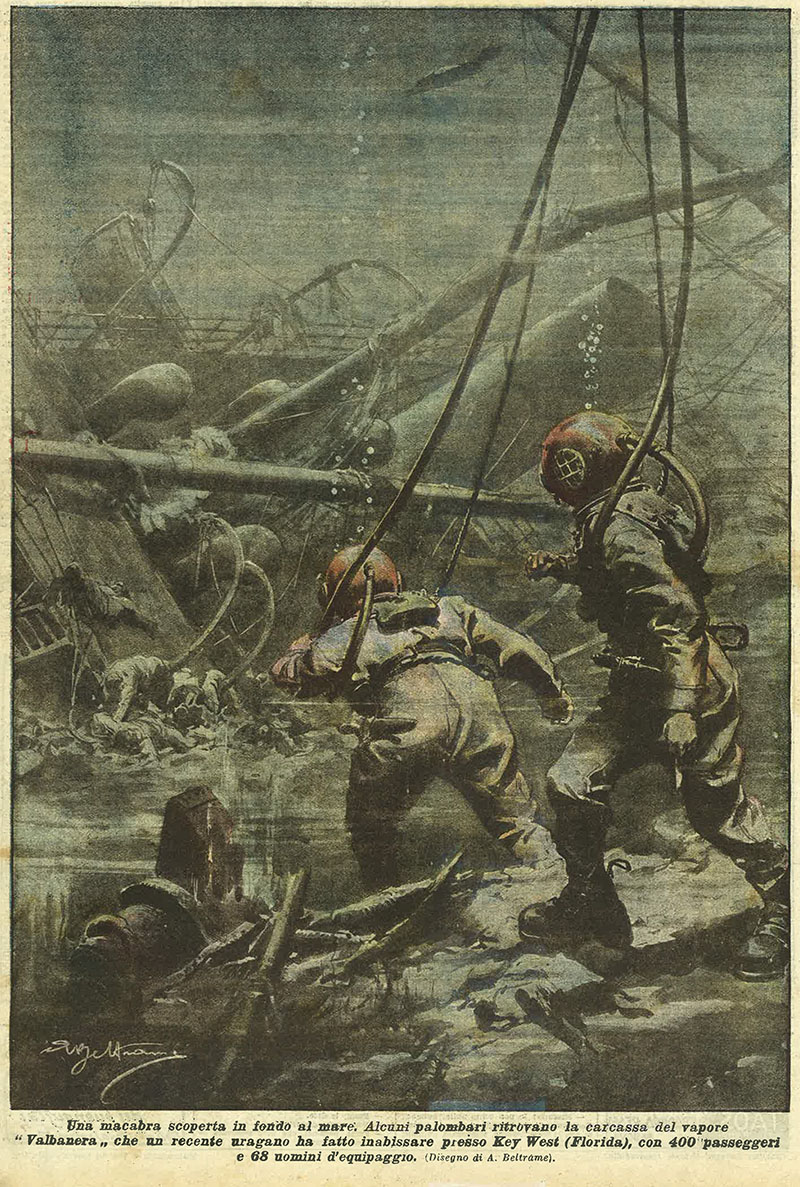
Stretching south and west from the Florida peninsula, the Florida Keys separate the Gulf of Mexico from the Atlantic Ocean. Not long after Christopher Columbus’s exploratory voyages to the Caribbean, vessels engaged in Spanish colonial expansion began using the Gulf Stream to return to Spain loaded with precious metals and other valuable goods from the Americas. Known to these Spanish mariners as Los Martires (the Martyrs), the Florida Keys and its surrounding reef systems were the main geographic feature delimiting the north side of this ocean highway. During the past five centuries, many vessels fell victim to the shallow reefs and shoals surrounding the island chain, sinking in storms that claimed both the ships and the lives of the sailors riding the Gulf Stream north.
The westernmost shoals in the Keys became a graveyard for vessels pushed north by hurricane winds and waves as these destructive storms passed through the Caribbean. Captains failing to recognize the shoals extending from the Marquesas Keys towards the Dry Tortugas found themselves wrecked in the area nicknamed the “Quicksands.” Numerous historical shipwreck reports attribute the location of vessel losses to the Quicksands or more broadly the Marquesas Keys, which constitutes an area approximately 50 kilometers (31 miles) long by 15 kilometers (9 miles) wide. From 17th century Spanish galleons to 20th century steamships, the number of shipwrecks in the area is impressive. There are also certain specific vessels reported lost in the area that would have a high historical significance if found.

Detail of an 1827 chart by George Gauld and Edmund Blunt accurately depicting the “Quicksands.” Image courtesy of the David Rumsey Map Collection . Download image (jpg, 1.7 MB).
In 1622, the Tierra Firme fleet departed Havana harbor en route to Spain with 28 vessels in convoy. The cargo included gold and silver bullion and specie, as well as indigo, tobacco, cochineal, rosewood, and tons of copper ingots (Smith, 1988). A hurricane struck the convoy soon after it left port. The storm sank eight of the ships; some grounded in the shallows of the Dry Tortugas and near the Marquesas Keys while others sank in deeper water (Smith 1988, Mathewson 1986).
In the months and years after the storm, Spanish salvors recovered significant armament and cargo from the wreckage of Nuestra Señora de Rosario in the Dry Tortugas and especially Santa Margarita in the Quicksands, but subsequent storms fragmented the other wrecks which were then covered by shifting sands preventing their relocation (Smith 1988). Spanish salvage activity directed at finding the Nuestra Señora de Atocha and recovering the cargo of Santa Margarita brought intense European activity to the area. This activity level was not likely equaled again until the nineteenth century.
The islands on which the Spanish built salvage camps and from which they searched for and salvaged the wrecks were named after the Marquis de Cadereita, the commander of the 1622 fleet. He also led the initial contemporary salvage of the shipwrecks, and his name lives on today in the Marquesas Keys. Of the eight ships that were part of the 1622 Tierra Firme fleet, four have been found through the efforts of archaeologists and historic shipwreck salvage organizations (Johnson, 1982; Mathewson, 1986; Kingsley, 2013). Other ships from the 1622 fleet or lost during salvage activities may be found in the survey area.

Seventeenth century vessels caught in a tempest. Image courtesy of the National Gallery of Art, Alisa Mellon Bruce Fund. Download image (jpg, 9.3 MB).
Maritime activity in the area increased through the centuries following the 1622 fleet disaster. During the nineteenth century, ocean-borne traffic funneled around the Dry Tortugas, connecting the Gulf of Mexico to the larger Atlantic world. This trend is evidenced by the domination in the historical record of shipwrecked vessels carrying agricultural and forest products from Gulf ports to European industrial centers.
The exploitation of enslaved African labor to create wealth from agricultural production is also associated with shipwrecks in the region. The location of the slave ship Henrietta Marie on nearby New Ground Reef speaks to this widespread and horrific trade. Archaeological excavation of the vessel, which sank following a slaving voyage from Africa to Jamaica in 1700, provides an invaluable view point on the Middle Passage (Malcom, 2001). Over 150 years later, slaving voyages continued to interact with the project area as reported in the intentional wrecking of the American brig Martha Regan, following an illegal slaving voyage to Cuba in 1859 (Memphis Daily Avalanche, 1859).
Another highly significant shipwreck reported in this area is the Spanish steamship Valbanera, reportedly wrecked on Halfmoon Shoal during a hurricane in September 1919. Built in 1906 by Connell and Co. of Glasgow, Scotland, the steel screw steamship measured 121.9 meters (399.7 feet) long with a maximum breadth of 14.6 meters (48 feet) and a 6.5-meter (21.5-foot) depth of hold. It operated between Spain and Cuba for the Pinillos Steamship Line. On its last voyage from Barcelona to Cuba, it called at Santiago de Cuba, disembarking 749 of its 1,142 passengers, who were Spanish immigrants. Continuing on to Havana, port officials did not allow the steamship to enter the harbor, which had been closed due to an impending hurricane. The ship radioed that it would move into deeper water to ride out the storm, but was never heard from again. Several days later, U.S. Navy and Coast Guard vessels located a wreck identified as Valbanera submerged at Halfmoon Shoal. None of the 488 passengers or crew survived and no bodies were ever found (Lloyd’s, 1919; Decker, 2005; Echegoyen, 1999). The shipwreck even inspired Ernest Hemingway to write “After the Storm,” a short story about a diver who discovers a sunken steamship off of the Marquesas but is thwarted in his attempts to recover its riches. Local divers and a team led by Spanish historian Fernando Jose García Echegoyen have reportedly visited a shipwreck believed to be the Valbanera (Lyon 1989; Echegoyen 2019).

Fanciful depiction of divers exploring Valbanera from the Italian newspaper La Domenica del Corriere published in Milan. Image courtesy of Matthew Lawrence. Download image (jpg, 7.1 MB).
Decker, Benton C.
2005 Loss of the Steamship Valbanera. Florida Keys Sea Heritage Journal. Vol. 15 No. 3, Spring 2005.
Echegoyen, Fernando Jose Garcia
1999 The Last Trip of Valbanera. Florida Keys Sea Heritage Journal. Vol. 6 No. 4. Key West Maritime Historical Society of the Florida Keys.
2019 Regreso Al Valbanera: Historia Visual de un Naufragio Espanol. Fernando Jose Garcia Echegoyen, www.echegoyen.es .
Johnson, Richard
1982 Underwater Archaeological Investigations at FOJE-UW-9 Conducted in Summer 1982 at Fort Jefferson National Monument, Dry Tortugas, Florida. Tallahassee: National Park Service Southeastern Archaeological Center.
Kingsley, Sean
2013 The Identity and Maritime History of the Deep-Sea Tortugas Shipwreck. In Oceans Odyssey 3: The Deep-Sea Tortugas Shipwreck, Straits of Florida: A Merchant Vessel from Spain’s Tierra Firme Fleet, Greg Stemm and Sean Kinglsely, editors, Oxbow Books, Oxford, UK.
Lyon, Eugene
1989 The Search for the Atocha. Florida Classics Library, Port Salerno, FL.
Malcom, Corey
2001 A Re-examination of the Hull of the Henrietta Marie. Report in accordance with FKNMS Permit 00-046. Mel Fisher Maritime Heritage Society, Key West, FL.
Mathewson III, Duncan
1986 Treasure of the Atocha. Pisces Books, New York, NY.
Memphis Daily Avalanche
1859 A Slaver Ashore on the Coast of Florida. 23 March 1859, Vol. III., No. 51, pg. 3, Memphis, TN.
Singer, Stephen
2011 Shipwrecks of Florida: A Comprehensive Listing. Pineapple Press, Sarasota, FL.
Smith, Roger.
1988 Treasure Ships of the Spanish Main: The Iberian-American Maritime Empires. In George Bass (ed.), Ships and Shipwrecks of the Americas: A History Based on Underwater Archaeology. Thames and Hudson, London, UK